Clinical Case Study Analysis of Patient Betsy in NURBN2012 Assignment
VerifiedAdded on 2023/04/20
|14
|4667
|158
Report
AI Summary
This report analyzes a clinical case study of a patient experiencing symptoms of acute coronary syndrome. It delves into the rationale for ECG requests, explaining how ECG assessment aids in diagnosing heart function and breathing patterns, crucial for identifying underlying conditions like angina. The report explores the pathophysiology of angina, detailing its causes and mechanisms, including the role of adenosine and the impact of oxygen demand on the heart. It differentiates between stable and unstable angina, as well as STEMI and NSTEMI, and identifies the patient's risk factors. The analysis includes an interpretation of the patient's ECG, identifying an underlying arrhythmia. It discusses the clinical criteria for acute coronary syndrome, encompassing physical examination, patient history, and diagnostic tests. The report examines drug therapies, including GTN, Diltiazem, Pravastatin, Ticagrelor with Aspirin, and Morphine, detailing their mechanisms of action, side effects, and nursing considerations. The assignment fulfills the requirements of NURBN2012, demonstrating a strong understanding of pathophysiology, pharmacology, and patient care, supported by current research and literature, and includes a discussion of ECG analysis and drug therapy.
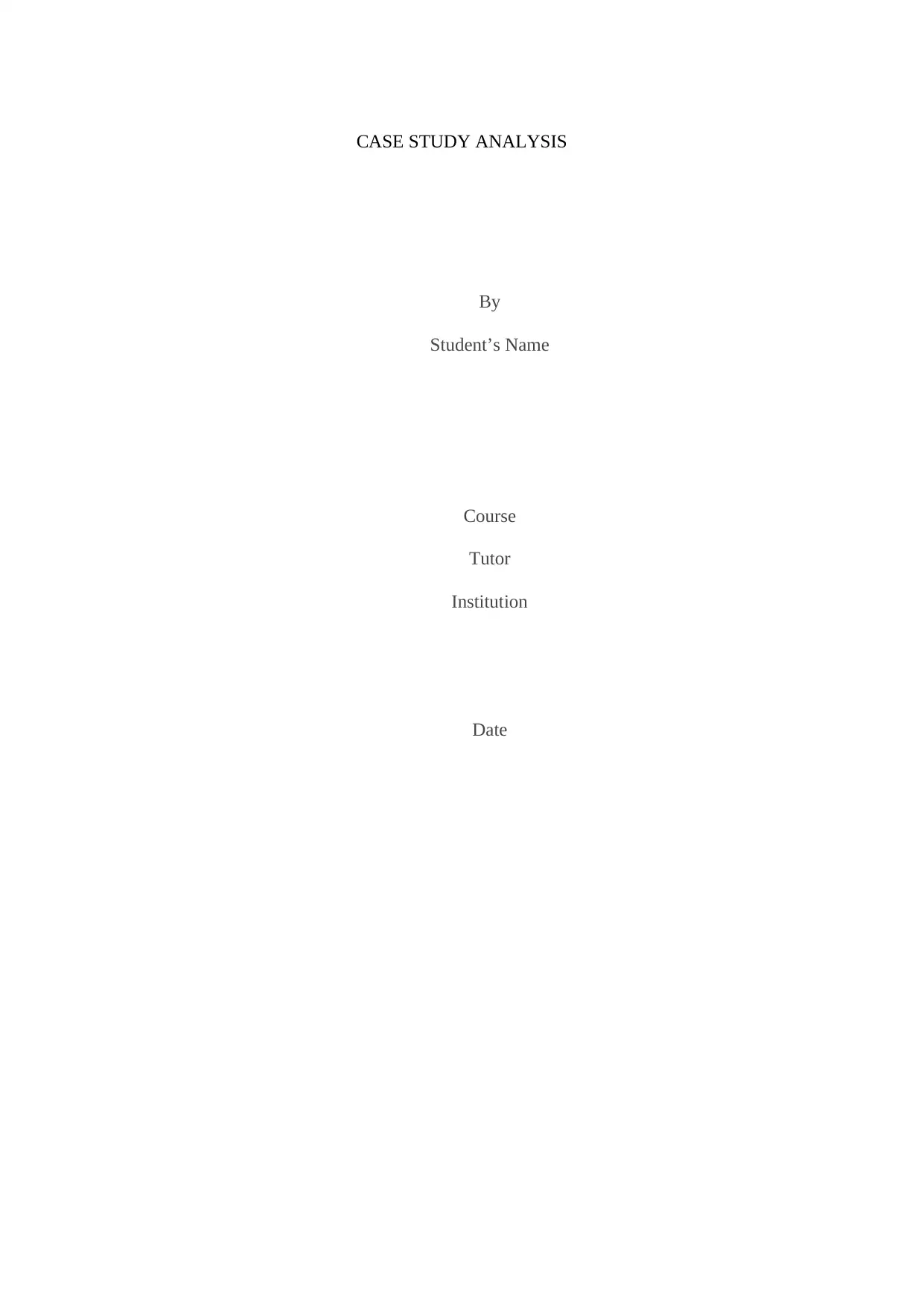
CASE STUDY ANALYSIS
By
Student’s Name
Course
Tutor
Institution
Date
By
Student’s Name
Course
Tutor
Institution
Date
Paraphrase This Document
Need a fresh take? Get an instant paraphrase of this document with our AI Paraphraser
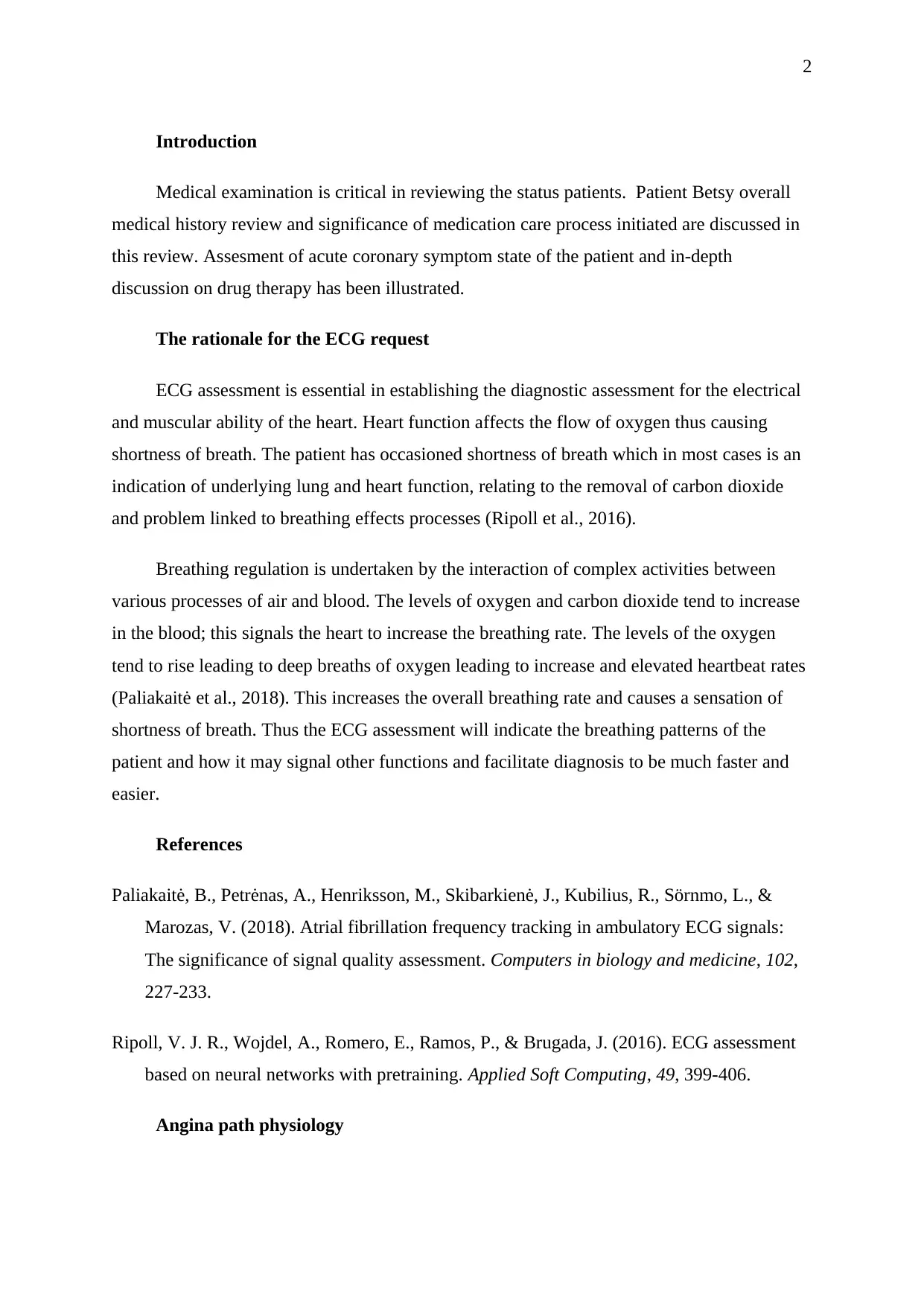
2
Introduction
Medical examination is critical in reviewing the status patients. Patient Betsy overall
medical history review and significance of medication care process initiated are discussed in
this review. Assesment of acute coronary symptom state of the patient and in-depth
discussion on drug therapy has been illustrated.
The rationale for the ECG request
ECG assessment is essential in establishing the diagnostic assessment for the electrical
and muscular ability of the heart. Heart function affects the flow of oxygen thus causing
shortness of breath. The patient has occasioned shortness of breath which in most cases is an
indication of underlying lung and heart function, relating to the removal of carbon dioxide
and problem linked to breathing effects processes (Ripoll et al., 2016).
Breathing regulation is undertaken by the interaction of complex activities between
various processes of air and blood. The levels of oxygen and carbon dioxide tend to increase
in the blood; this signals the heart to increase the breathing rate. The levels of the oxygen
tend to rise leading to deep breaths of oxygen leading to increase and elevated heartbeat rates
(Paliakaitė et al., 2018). This increases the overall breathing rate and causes a sensation of
shortness of breath. Thus the ECG assessment will indicate the breathing patterns of the
patient and how it may signal other functions and facilitate diagnosis to be much faster and
easier.
References
Paliakaitė, B., Petrėnas, A., Henriksson, M., Skibarkienė, J., Kubilius, R., Sörnmo, L., &
Marozas, V. (2018). Atrial fibrillation frequency tracking in ambulatory ECG signals:
The significance of signal quality assessment. Computers in biology and medicine, 102,
227-233.
Ripoll, V. J. R., Wojdel, A., Romero, E., Ramos, P., & Brugada, J. (2016). ECG assessment
based on neural networks with pretraining. Applied Soft Computing, 49, 399-406.
Angina path physiology
Introduction
Medical examination is critical in reviewing the status patients. Patient Betsy overall
medical history review and significance of medication care process initiated are discussed in
this review. Assesment of acute coronary symptom state of the patient and in-depth
discussion on drug therapy has been illustrated.
The rationale for the ECG request
ECG assessment is essential in establishing the diagnostic assessment for the electrical
and muscular ability of the heart. Heart function affects the flow of oxygen thus causing
shortness of breath. The patient has occasioned shortness of breath which in most cases is an
indication of underlying lung and heart function, relating to the removal of carbon dioxide
and problem linked to breathing effects processes (Ripoll et al., 2016).
Breathing regulation is undertaken by the interaction of complex activities between
various processes of air and blood. The levels of oxygen and carbon dioxide tend to increase
in the blood; this signals the heart to increase the breathing rate. The levels of the oxygen
tend to rise leading to deep breaths of oxygen leading to increase and elevated heartbeat rates
(Paliakaitė et al., 2018). This increases the overall breathing rate and causes a sensation of
shortness of breath. Thus the ECG assessment will indicate the breathing patterns of the
patient and how it may signal other functions and facilitate diagnosis to be much faster and
easier.
References
Paliakaitė, B., Petrėnas, A., Henriksson, M., Skibarkienė, J., Kubilius, R., Sörnmo, L., &
Marozas, V. (2018). Atrial fibrillation frequency tracking in ambulatory ECG signals:
The significance of signal quality assessment. Computers in biology and medicine, 102,
227-233.
Ripoll, V. J. R., Wojdel, A., Romero, E., Ramos, P., & Brugada, J. (2016). ECG assessment
based on neural networks with pretraining. Applied Soft Computing, 49, 399-406.
Angina path physiology
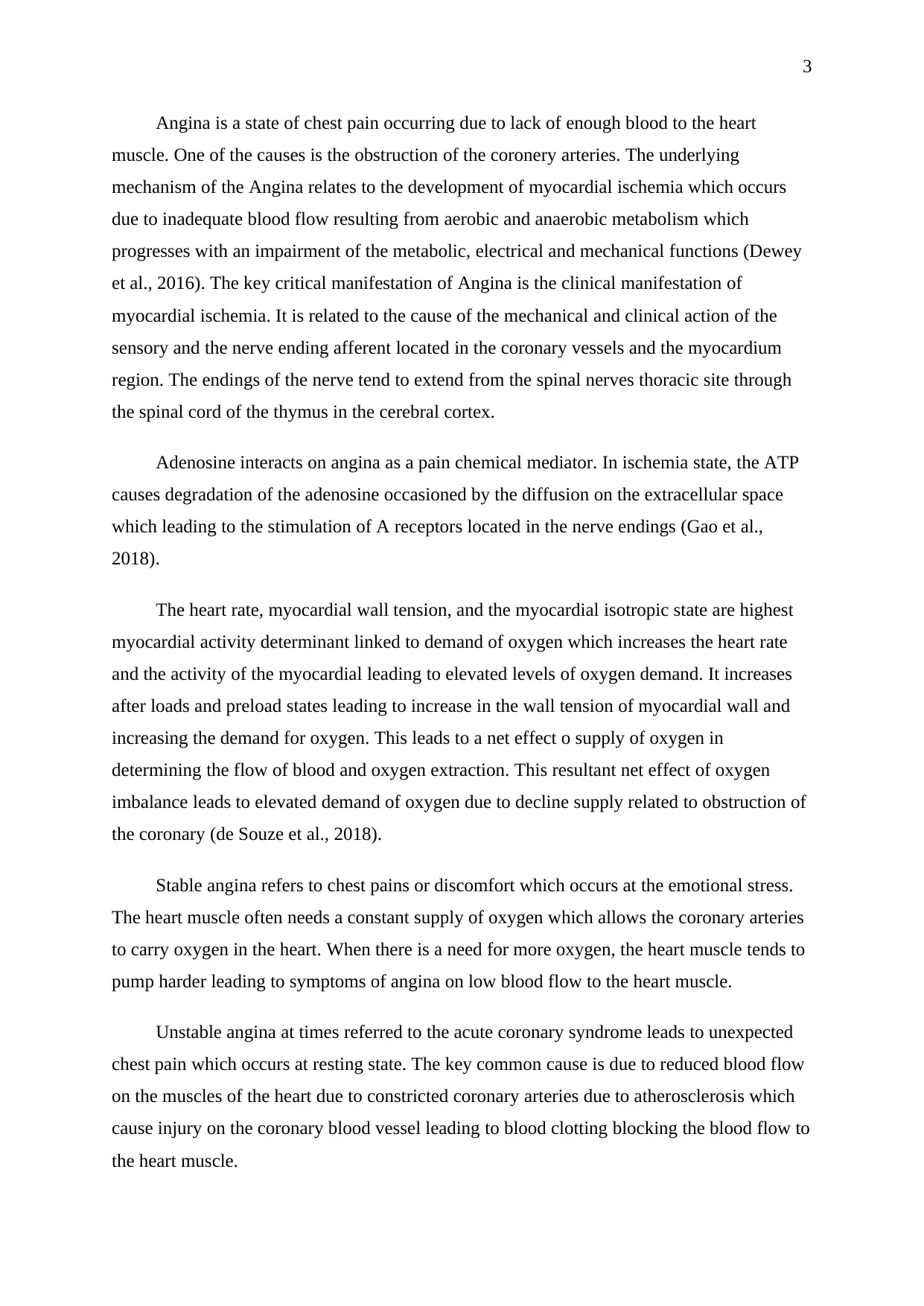
3
Angina is a state of chest pain occurring due to lack of enough blood to the heart
muscle. One of the causes is the obstruction of the coronery arteries. The underlying
mechanism of the Angina relates to the development of myocardial ischemia which occurs
due to inadequate blood flow resulting from aerobic and anaerobic metabolism which
progresses with an impairment of the metabolic, electrical and mechanical functions (Dewey
et al., 2016). The key critical manifestation of Angina is the clinical manifestation of
myocardial ischemia. It is related to the cause of the mechanical and clinical action of the
sensory and the nerve ending afferent located in the coronary vessels and the myocardium
region. The endings of the nerve tend to extend from the spinal nerves thoracic site through
the spinal cord of the thymus in the cerebral cortex.
Adenosine interacts on angina as a pain chemical mediator. In ischemia state, the ATP
causes degradation of the adenosine occasioned by the diffusion on the extracellular space
which leading to the stimulation of A receptors located in the nerve endings (Gao et al.,
2018).
The heart rate, myocardial wall tension, and the myocardial isotropic state are highest
myocardial activity determinant linked to demand of oxygen which increases the heart rate
and the activity of the myocardial leading to elevated levels of oxygen demand. It increases
after loads and preload states leading to increase in the wall tension of myocardial wall and
increasing the demand for oxygen. This leads to a net effect o supply of oxygen in
determining the flow of blood and oxygen extraction. This resultant net effect of oxygen
imbalance leads to elevated demand of oxygen due to decline supply related to obstruction of
the coronary (de Souze et al., 2018).
Stable angina refers to chest pains or discomfort which occurs at the emotional stress.
The heart muscle often needs a constant supply of oxygen which allows the coronary arteries
to carry oxygen in the heart. When there is a need for more oxygen, the heart muscle tends to
pump harder leading to symptoms of angina on low blood flow to the heart muscle.
Unstable angina at times referred to the acute coronary syndrome leads to unexpected
chest pain which occurs at resting state. The key common cause is due to reduced blood flow
on the muscles of the heart due to constricted coronary arteries due to atherosclerosis which
cause injury on the coronary blood vessel leading to blood clotting blocking the blood flow to
the heart muscle.
Angina is a state of chest pain occurring due to lack of enough blood to the heart
muscle. One of the causes is the obstruction of the coronery arteries. The underlying
mechanism of the Angina relates to the development of myocardial ischemia which occurs
due to inadequate blood flow resulting from aerobic and anaerobic metabolism which
progresses with an impairment of the metabolic, electrical and mechanical functions (Dewey
et al., 2016). The key critical manifestation of Angina is the clinical manifestation of
myocardial ischemia. It is related to the cause of the mechanical and clinical action of the
sensory and the nerve ending afferent located in the coronary vessels and the myocardium
region. The endings of the nerve tend to extend from the spinal nerves thoracic site through
the spinal cord of the thymus in the cerebral cortex.
Adenosine interacts on angina as a pain chemical mediator. In ischemia state, the ATP
causes degradation of the adenosine occasioned by the diffusion on the extracellular space
which leading to the stimulation of A receptors located in the nerve endings (Gao et al.,
2018).
The heart rate, myocardial wall tension, and the myocardial isotropic state are highest
myocardial activity determinant linked to demand of oxygen which increases the heart rate
and the activity of the myocardial leading to elevated levels of oxygen demand. It increases
after loads and preload states leading to increase in the wall tension of myocardial wall and
increasing the demand for oxygen. This leads to a net effect o supply of oxygen in
determining the flow of blood and oxygen extraction. This resultant net effect of oxygen
imbalance leads to elevated demand of oxygen due to decline supply related to obstruction of
the coronary (de Souze et al., 2018).
Stable angina refers to chest pains or discomfort which occurs at the emotional stress.
The heart muscle often needs a constant supply of oxygen which allows the coronary arteries
to carry oxygen in the heart. When there is a need for more oxygen, the heart muscle tends to
pump harder leading to symptoms of angina on low blood flow to the heart muscle.
Unstable angina at times referred to the acute coronary syndrome leads to unexpected
chest pain which occurs at resting state. The key common cause is due to reduced blood flow
on the muscles of the heart due to constricted coronary arteries due to atherosclerosis which
cause injury on the coronary blood vessel leading to blood clotting blocking the blood flow to
the heart muscle.
⊘ This is a preview!⊘
Do you want full access?
Subscribe today to unlock all pages.

Trusted by 1+ million students worldwide
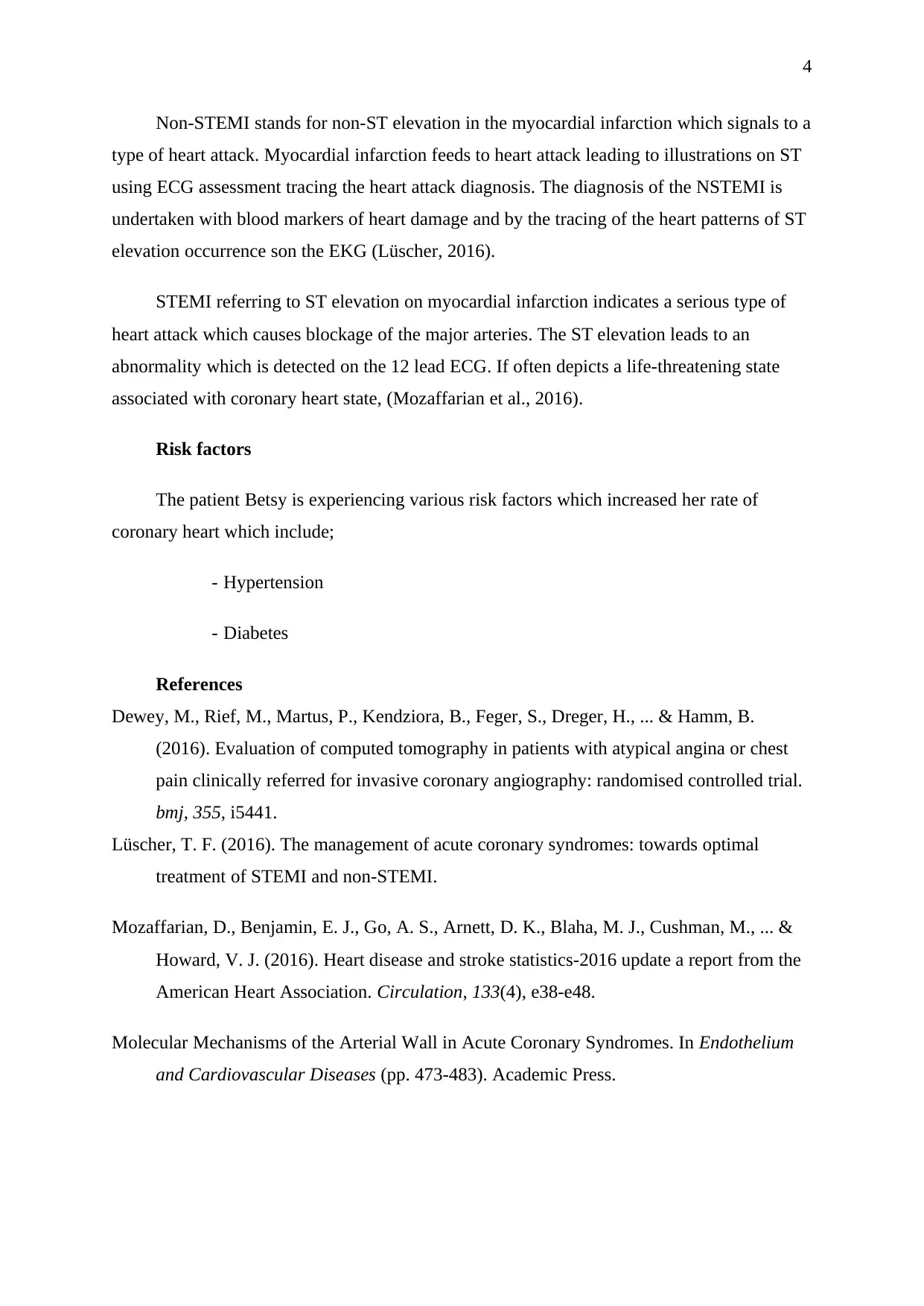
4
Non-STEMI stands for non-ST elevation in the myocardial infarction which signals to a
type of heart attack. Myocardial infarction feeds to heart attack leading to illustrations on ST
using ECG assessment tracing the heart attack diagnosis. The diagnosis of the NSTEMI is
undertaken with blood markers of heart damage and by the tracing of the heart patterns of ST
elevation occurrence son the EKG (Lüscher, 2016).
STEMI referring to ST elevation on myocardial infarction indicates a serious type of
heart attack which causes blockage of the major arteries. The ST elevation leads to an
abnormality which is detected on the 12 lead ECG. If often depicts a life-threatening state
associated with coronary heart state, (Mozaffarian et al., 2016).
Risk factors
The patient Betsy is experiencing various risk factors which increased her rate of
coronary heart which include;
- Hypertension
- Diabetes
References
Dewey, M., Rief, M., Martus, P., Kendziora, B., Feger, S., Dreger, H., ... & Hamm, B.
(2016). Evaluation of computed tomography in patients with atypical angina or chest
pain clinically referred for invasive coronary angiography: randomised controlled trial.
bmj, 355, i5441.
Lüscher, T. F. (2016). The management of acute coronary syndromes: towards optimal
treatment of STEMI and non-STEMI.
Mozaffarian, D., Benjamin, E. J., Go, A. S., Arnett, D. K., Blaha, M. J., Cushman, M., ... &
Howard, V. J. (2016). Heart disease and stroke statistics-2016 update a report from the
American Heart Association. Circulation, 133(4), e38-e48.
Molecular Mechanisms of the Arterial Wall in Acute Coronary Syndromes. In Endothelium
and Cardiovascular Diseases (pp. 473-483). Academic Press.
Non-STEMI stands for non-ST elevation in the myocardial infarction which signals to a
type of heart attack. Myocardial infarction feeds to heart attack leading to illustrations on ST
using ECG assessment tracing the heart attack diagnosis. The diagnosis of the NSTEMI is
undertaken with blood markers of heart damage and by the tracing of the heart patterns of ST
elevation occurrence son the EKG (Lüscher, 2016).
STEMI referring to ST elevation on myocardial infarction indicates a serious type of
heart attack which causes blockage of the major arteries. The ST elevation leads to an
abnormality which is detected on the 12 lead ECG. If often depicts a life-threatening state
associated with coronary heart state, (Mozaffarian et al., 2016).
Risk factors
The patient Betsy is experiencing various risk factors which increased her rate of
coronary heart which include;
- Hypertension
- Diabetes
References
Dewey, M., Rief, M., Martus, P., Kendziora, B., Feger, S., Dreger, H., ... & Hamm, B.
(2016). Evaluation of computed tomography in patients with atypical angina or chest
pain clinically referred for invasive coronary angiography: randomised controlled trial.
bmj, 355, i5441.
Lüscher, T. F. (2016). The management of acute coronary syndromes: towards optimal
treatment of STEMI and non-STEMI.
Mozaffarian, D., Benjamin, E. J., Go, A. S., Arnett, D. K., Blaha, M. J., Cushman, M., ... &
Howard, V. J. (2016). Heart disease and stroke statistics-2016 update a report from the
American Heart Association. Circulation, 133(4), e38-e48.
Molecular Mechanisms of the Arterial Wall in Acute Coronary Syndromes. In Endothelium
and Cardiovascular Diseases (pp. 473-483). Academic Press.
Paraphrase This Document
Need a fresh take? Get an instant paraphrase of this document with our AI Paraphraser
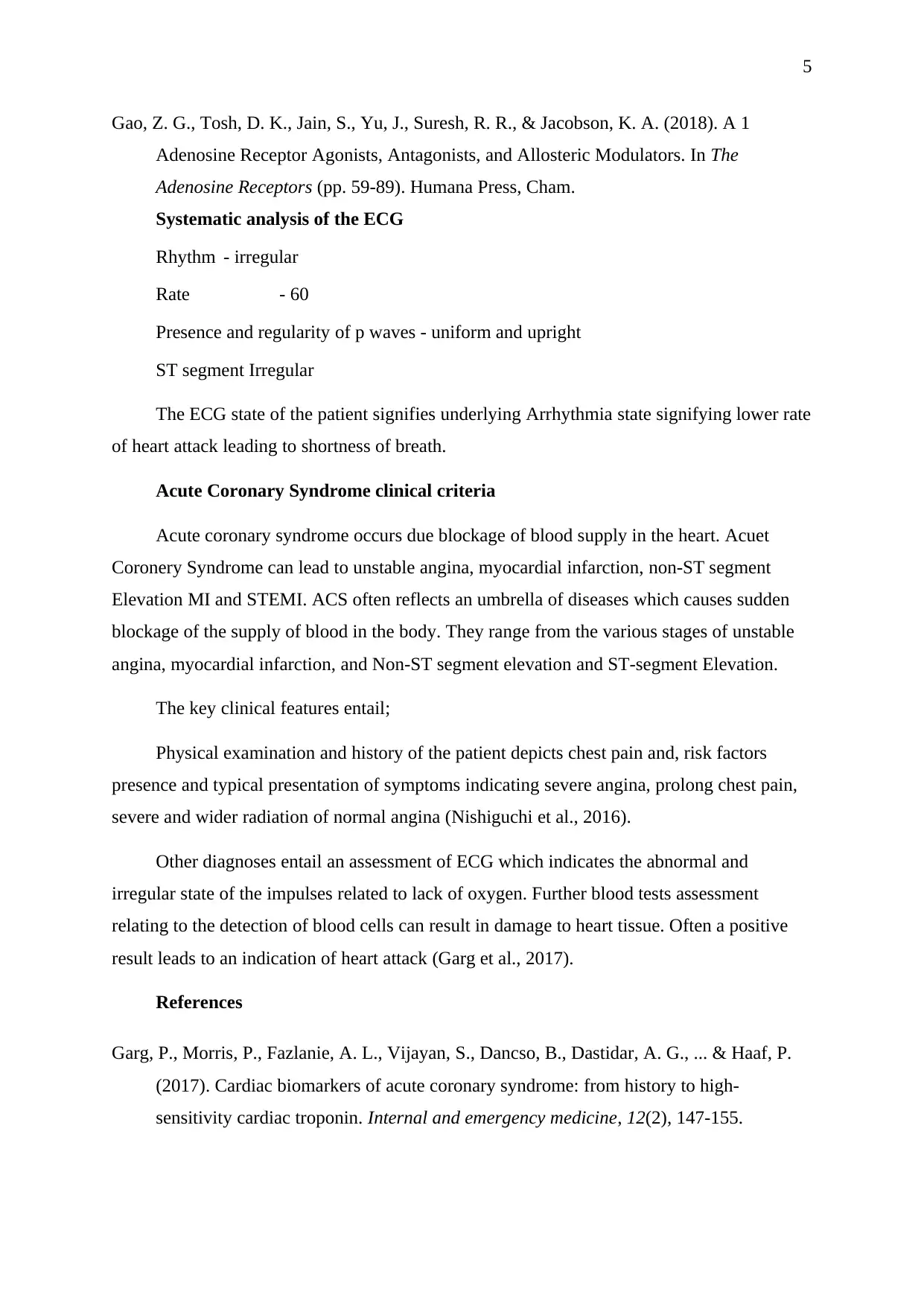
5
Gao, Z. G., Tosh, D. K., Jain, S., Yu, J., Suresh, R. R., & Jacobson, K. A. (2018). A 1
Adenosine Receptor Agonists, Antagonists, and Allosteric Modulators. In The
Adenosine Receptors (pp. 59-89). Humana Press, Cham.
Systematic analysis of the ECG
Rhythm - irregular
Rate - 60
Presence and regularity of p waves - uniform and upright
ST segment Irregular
The ECG state of the patient signifies underlying Arrhythmia state signifying lower rate
of heart attack leading to shortness of breath.
Acute Coronary Syndrome clinical criteria
Acute coronary syndrome occurs due blockage of blood supply in the heart. Acuet
Coronery Syndrome can lead to unstable angina, myocardial infarction, non-ST segment
Elevation MI and STEMI. ACS often reflects an umbrella of diseases which causes sudden
blockage of the supply of blood in the body. They range from the various stages of unstable
angina, myocardial infarction, and Non-ST segment elevation and ST-segment Elevation.
The key clinical features entail;
Physical examination and history of the patient depicts chest pain and, risk factors
presence and typical presentation of symptoms indicating severe angina, prolong chest pain,
severe and wider radiation of normal angina (Nishiguchi et al., 2016).
Other diagnoses entail an assessment of ECG which indicates the abnormal and
irregular state of the impulses related to lack of oxygen. Further blood tests assessment
relating to the detection of blood cells can result in damage to heart tissue. Often a positive
result leads to an indication of heart attack (Garg et al., 2017).
References
Garg, P., Morris, P., Fazlanie, A. L., Vijayan, S., Dancso, B., Dastidar, A. G., ... & Haaf, P.
(2017). Cardiac biomarkers of acute coronary syndrome: from history to high-
sensitivity cardiac troponin. Internal and emergency medicine, 12(2), 147-155.
Gao, Z. G., Tosh, D. K., Jain, S., Yu, J., Suresh, R. R., & Jacobson, K. A. (2018). A 1
Adenosine Receptor Agonists, Antagonists, and Allosteric Modulators. In The
Adenosine Receptors (pp. 59-89). Humana Press, Cham.
Systematic analysis of the ECG
Rhythm - irregular
Rate - 60
Presence and regularity of p waves - uniform and upright
ST segment Irregular
The ECG state of the patient signifies underlying Arrhythmia state signifying lower rate
of heart attack leading to shortness of breath.
Acute Coronary Syndrome clinical criteria
Acute coronary syndrome occurs due blockage of blood supply in the heart. Acuet
Coronery Syndrome can lead to unstable angina, myocardial infarction, non-ST segment
Elevation MI and STEMI. ACS often reflects an umbrella of diseases which causes sudden
blockage of the supply of blood in the body. They range from the various stages of unstable
angina, myocardial infarction, and Non-ST segment elevation and ST-segment Elevation.
The key clinical features entail;
Physical examination and history of the patient depicts chest pain and, risk factors
presence and typical presentation of symptoms indicating severe angina, prolong chest pain,
severe and wider radiation of normal angina (Nishiguchi et al., 2016).
Other diagnoses entail an assessment of ECG which indicates the abnormal and
irregular state of the impulses related to lack of oxygen. Further blood tests assessment
relating to the detection of blood cells can result in damage to heart tissue. Often a positive
result leads to an indication of heart attack (Garg et al., 2017).
References
Garg, P., Morris, P., Fazlanie, A. L., Vijayan, S., Dancso, B., Dastidar, A. G., ... & Haaf, P.
(2017). Cardiac biomarkers of acute coronary syndrome: from history to high-
sensitivity cardiac troponin. Internal and emergency medicine, 12(2), 147-155.
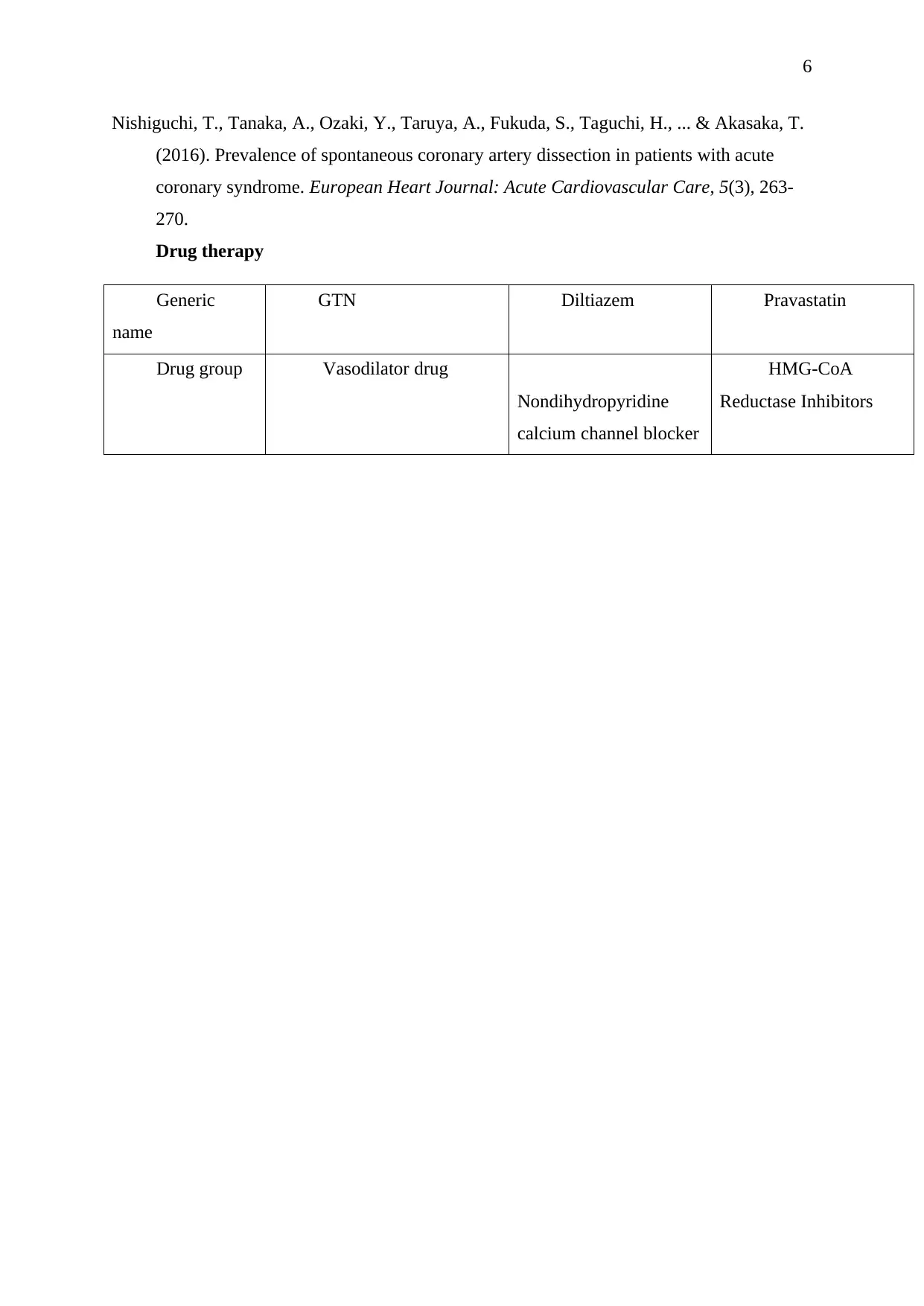
6
Nishiguchi, T., Tanaka, A., Ozaki, Y., Taruya, A., Fukuda, S., Taguchi, H., ... & Akasaka, T.
(2016). Prevalence of spontaneous coronary artery dissection in patients with acute
coronary syndrome. European Heart Journal: Acute Cardiovascular Care, 5(3), 263-
270.
Drug therapy
Generic
name
GTN Diltiazem Pravastatin
Drug group Vasodilator drug
Nondihydropyridine
calcium channel blocker
HMG-CoA
Reductase Inhibitors
Nishiguchi, T., Tanaka, A., Ozaki, Y., Taruya, A., Fukuda, S., Taguchi, H., ... & Akasaka, T.
(2016). Prevalence of spontaneous coronary artery dissection in patients with acute
coronary syndrome. European Heart Journal: Acute Cardiovascular Care, 5(3), 263-
270.
Drug therapy
Generic
name
GTN Diltiazem Pravastatin
Drug group Vasodilator drug
Nondihydropyridine
calcium channel blocker
HMG-CoA
Reductase Inhibitors
⊘ This is a preview!⊘
Do you want full access?
Subscribe today to unlock all pages.

Trusted by 1+ million students worldwide
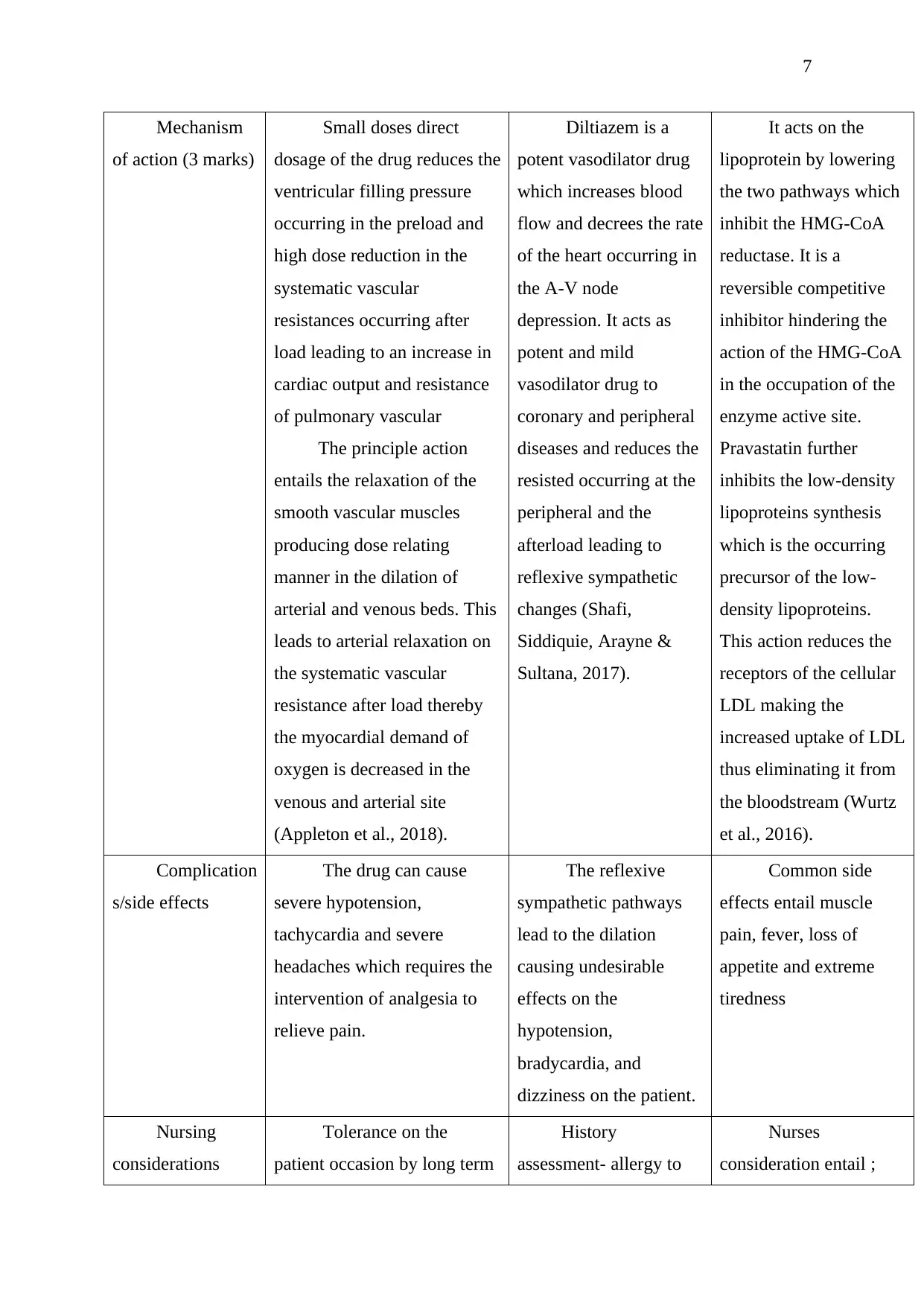
7
Mechanism
of action (3 marks)
Small doses direct
dosage of the drug reduces the
ventricular filling pressure
occurring in the preload and
high dose reduction in the
systematic vascular
resistances occurring after
load leading to an increase in
cardiac output and resistance
of pulmonary vascular
The principle action
entails the relaxation of the
smooth vascular muscles
producing dose relating
manner in the dilation of
arterial and venous beds. This
leads to arterial relaxation on
the systematic vascular
resistance after load thereby
the myocardial demand of
oxygen is decreased in the
venous and arterial site
(Appleton et al., 2018).
Diltiazem is a
potent vasodilator drug
which increases blood
flow and decrees the rate
of the heart occurring in
the A-V node
depression. It acts as
potent and mild
vasodilator drug to
coronary and peripheral
diseases and reduces the
resisted occurring at the
peripheral and the
afterload leading to
reflexive sympathetic
changes (Shafi,
Siddiquie, Arayne &
Sultana, 2017).
It acts on the
lipoprotein by lowering
the two pathways which
inhibit the HMG-CoA
reductase. It is a
reversible competitive
inhibitor hindering the
action of the HMG-CoA
in the occupation of the
enzyme active site.
Pravastatin further
inhibits the low-density
lipoproteins synthesis
which is the occurring
precursor of the low-
density lipoproteins.
This action reduces the
receptors of the cellular
LDL making the
increased uptake of LDL
thus eliminating it from
the bloodstream (Wurtz
et al., 2016).
Complication
s/side effects
The drug can cause
severe hypotension,
tachycardia and severe
headaches which requires the
intervention of analgesia to
relieve pain.
The reflexive
sympathetic pathways
lead to the dilation
causing undesirable
effects on the
hypotension,
bradycardia, and
dizziness on the patient.
Common side
effects entail muscle
pain, fever, loss of
appetite and extreme
tiredness
Nursing
considerations
Tolerance on the
patient occasion by long term
History
assessment- allergy to
Nurses
consideration entail ;
Mechanism
of action (3 marks)
Small doses direct
dosage of the drug reduces the
ventricular filling pressure
occurring in the preload and
high dose reduction in the
systematic vascular
resistances occurring after
load leading to an increase in
cardiac output and resistance
of pulmonary vascular
The principle action
entails the relaxation of the
smooth vascular muscles
producing dose relating
manner in the dilation of
arterial and venous beds. This
leads to arterial relaxation on
the systematic vascular
resistance after load thereby
the myocardial demand of
oxygen is decreased in the
venous and arterial site
(Appleton et al., 2018).
Diltiazem is a
potent vasodilator drug
which increases blood
flow and decrees the rate
of the heart occurring in
the A-V node
depression. It acts as
potent and mild
vasodilator drug to
coronary and peripheral
diseases and reduces the
resisted occurring at the
peripheral and the
afterload leading to
reflexive sympathetic
changes (Shafi,
Siddiquie, Arayne &
Sultana, 2017).
It acts on the
lipoprotein by lowering
the two pathways which
inhibit the HMG-CoA
reductase. It is a
reversible competitive
inhibitor hindering the
action of the HMG-CoA
in the occupation of the
enzyme active site.
Pravastatin further
inhibits the low-density
lipoproteins synthesis
which is the occurring
precursor of the low-
density lipoproteins.
This action reduces the
receptors of the cellular
LDL making the
increased uptake of LDL
thus eliminating it from
the bloodstream (Wurtz
et al., 2016).
Complication
s/side effects
The drug can cause
severe hypotension,
tachycardia and severe
headaches which requires the
intervention of analgesia to
relieve pain.
The reflexive
sympathetic pathways
lead to the dilation
causing undesirable
effects on the
hypotension,
bradycardia, and
dizziness on the patient.
Common side
effects entail muscle
pain, fever, loss of
appetite and extreme
tiredness
Nursing
considerations
Tolerance on the
patient occasion by long term
History
assessment- allergy to
Nurses
consideration entail ;
Paraphrase This Document
Need a fresh take? Get an instant paraphrase of this document with our AI Paraphraser
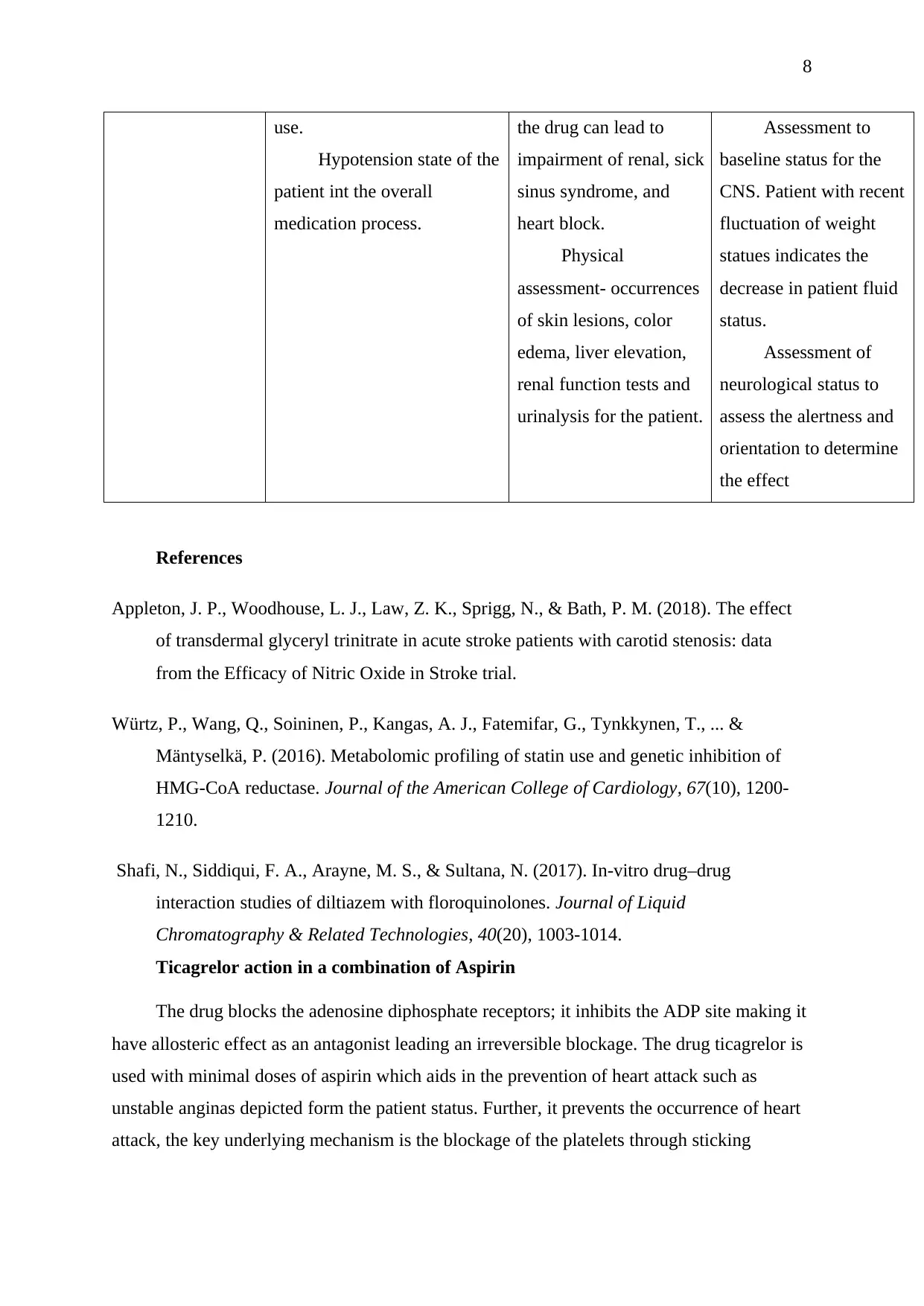
8
use.
Hypotension state of the
patient int the overall
medication process.
the drug can lead to
impairment of renal, sick
sinus syndrome, and
heart block.
Physical
assessment- occurrences
of skin lesions, color
edema, liver elevation,
renal function tests and
urinalysis for the patient.
Assessment to
baseline status for the
CNS. Patient with recent
fluctuation of weight
statues indicates the
decrease in patient fluid
status.
Assessment of
neurological status to
assess the alertness and
orientation to determine
the effect
References
Appleton, J. P., Woodhouse, L. J., Law, Z. K., Sprigg, N., & Bath, P. M. (2018). The effect
of transdermal glyceryl trinitrate in acute stroke patients with carotid stenosis: data
from the Efficacy of Nitric Oxide in Stroke trial.
Würtz, P., Wang, Q., Soininen, P., Kangas, A. J., Fatemifar, G., Tynkkynen, T., ... &
Mäntyselkä, P. (2016). Metabolomic profiling of statin use and genetic inhibition of
HMG-CoA reductase. Journal of the American College of Cardiology, 67(10), 1200-
1210.
Shafi, N., Siddiqui, F. A., Arayne, M. S., & Sultana, N. (2017). In-vitro drug–drug
interaction studies of diltiazem with floroquinolones. Journal of Liquid
Chromatography & Related Technologies, 40(20), 1003-1014.
Ticagrelor action in a combination of Aspirin
The drug blocks the adenosine diphosphate receptors; it inhibits the ADP site making it
have allosteric effect as an antagonist leading an irreversible blockage. The drug ticagrelor is
used with minimal doses of aspirin which aids in the prevention of heart attack such as
unstable anginas depicted form the patient status. Further, it prevents the occurrence of heart
attack, the key underlying mechanism is the blockage of the platelets through sticking
use.
Hypotension state of the
patient int the overall
medication process.
the drug can lead to
impairment of renal, sick
sinus syndrome, and
heart block.
Physical
assessment- occurrences
of skin lesions, color
edema, liver elevation,
renal function tests and
urinalysis for the patient.
Assessment to
baseline status for the
CNS. Patient with recent
fluctuation of weight
statues indicates the
decrease in patient fluid
status.
Assessment of
neurological status to
assess the alertness and
orientation to determine
the effect
References
Appleton, J. P., Woodhouse, L. J., Law, Z. K., Sprigg, N., & Bath, P. M. (2018). The effect
of transdermal glyceryl trinitrate in acute stroke patients with carotid stenosis: data
from the Efficacy of Nitric Oxide in Stroke trial.
Würtz, P., Wang, Q., Soininen, P., Kangas, A. J., Fatemifar, G., Tynkkynen, T., ... &
Mäntyselkä, P. (2016). Metabolomic profiling of statin use and genetic inhibition of
HMG-CoA reductase. Journal of the American College of Cardiology, 67(10), 1200-
1210.
Shafi, N., Siddiqui, F. A., Arayne, M. S., & Sultana, N. (2017). In-vitro drug–drug
interaction studies of diltiazem with floroquinolones. Journal of Liquid
Chromatography & Related Technologies, 40(20), 1003-1014.
Ticagrelor action in a combination of Aspirin
The drug blocks the adenosine diphosphate receptors; it inhibits the ADP site making it
have allosteric effect as an antagonist leading an irreversible blockage. The drug ticagrelor is
used with minimal doses of aspirin which aids in the prevention of heart attack such as
unstable anginas depicted form the patient status. Further, it prevents the occurrence of heart
attack, the key underlying mechanism is the blockage of the platelets through sticking
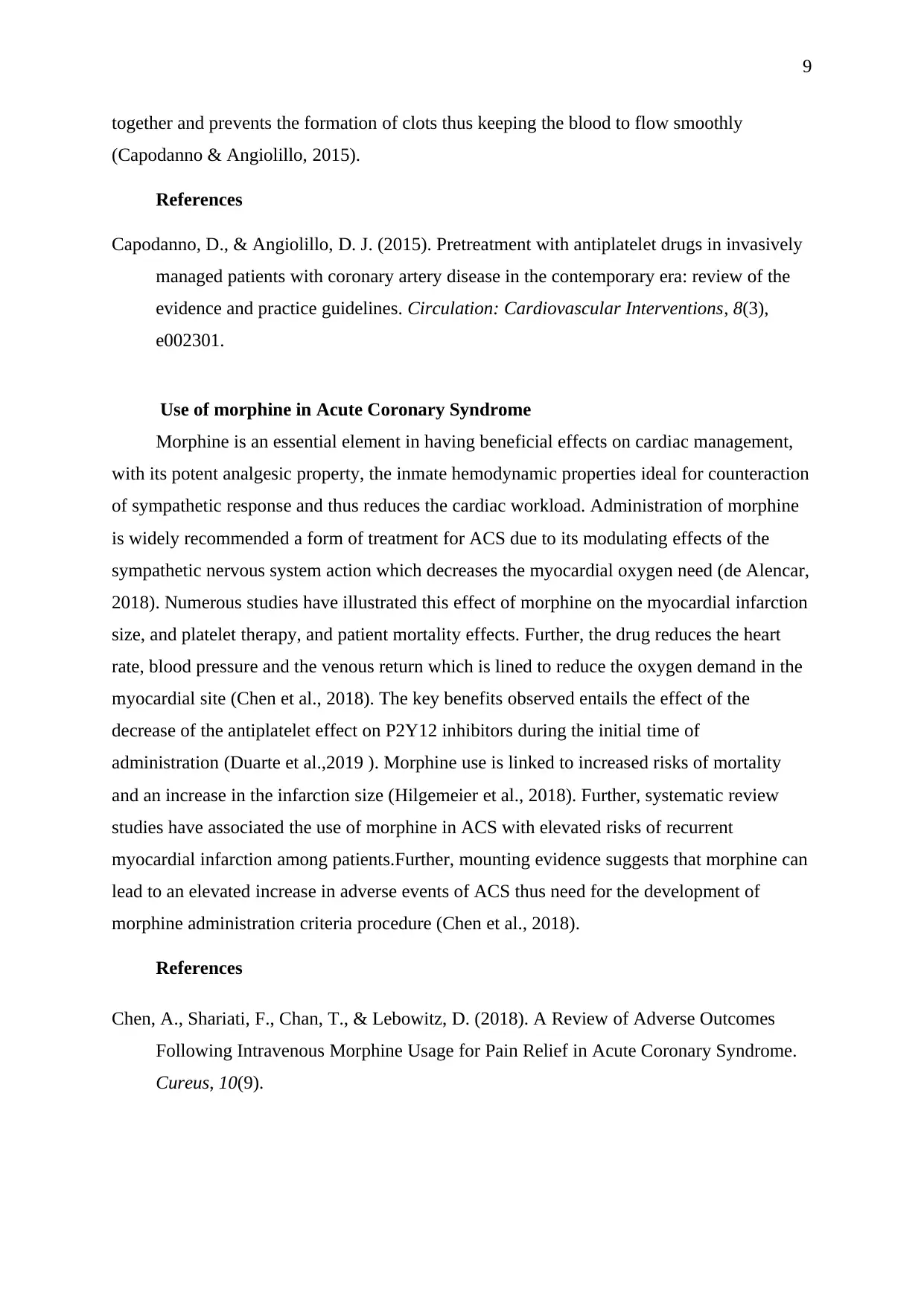
9
together and prevents the formation of clots thus keeping the blood to flow smoothly
(Capodanno & Angiolillo, 2015).
References
Capodanno, D., & Angiolillo, D. J. (2015). Pretreatment with antiplatelet drugs in invasively
managed patients with coronary artery disease in the contemporary era: review of the
evidence and practice guidelines. Circulation: Cardiovascular Interventions, 8(3),
e002301.
Use of morphine in Acute Coronary Syndrome
Morphine is an essential element in having beneficial effects on cardiac management,
with its potent analgesic property, the inmate hemodynamic properties ideal for counteraction
of sympathetic response and thus reduces the cardiac workload. Administration of morphine
is widely recommended a form of treatment for ACS due to its modulating effects of the
sympathetic nervous system action which decreases the myocardial oxygen need (de Alencar,
2018). Numerous studies have illustrated this effect of morphine on the myocardial infarction
size, and platelet therapy, and patient mortality effects. Further, the drug reduces the heart
rate, blood pressure and the venous return which is lined to reduce the oxygen demand in the
myocardial site (Chen et al., 2018). The key benefits observed entails the effect of the
decrease of the antiplatelet effect on P2Y12 inhibitors during the initial time of
administration (Duarte et al.,2019 ). Morphine use is linked to increased risks of mortality
and an increase in the infarction size (Hilgemeier et al., 2018). Further, systematic review
studies have associated the use of morphine in ACS with elevated risks of recurrent
myocardial infarction among patients.Further, mounting evidence suggests that morphine can
lead to an elevated increase in adverse events of ACS thus need for the development of
morphine administration criteria procedure (Chen et al., 2018).
References
Chen, A., Shariati, F., Chan, T., & Lebowitz, D. (2018). A Review of Adverse Outcomes
Following Intravenous Morphine Usage for Pain Relief in Acute Coronary Syndrome.
Cureus, 10(9).
together and prevents the formation of clots thus keeping the blood to flow smoothly
(Capodanno & Angiolillo, 2015).
References
Capodanno, D., & Angiolillo, D. J. (2015). Pretreatment with antiplatelet drugs in invasively
managed patients with coronary artery disease in the contemporary era: review of the
evidence and practice guidelines. Circulation: Cardiovascular Interventions, 8(3),
e002301.
Use of morphine in Acute Coronary Syndrome
Morphine is an essential element in having beneficial effects on cardiac management,
with its potent analgesic property, the inmate hemodynamic properties ideal for counteraction
of sympathetic response and thus reduces the cardiac workload. Administration of morphine
is widely recommended a form of treatment for ACS due to its modulating effects of the
sympathetic nervous system action which decreases the myocardial oxygen need (de Alencar,
2018). Numerous studies have illustrated this effect of morphine on the myocardial infarction
size, and platelet therapy, and patient mortality effects. Further, the drug reduces the heart
rate, blood pressure and the venous return which is lined to reduce the oxygen demand in the
myocardial site (Chen et al., 2018). The key benefits observed entails the effect of the
decrease of the antiplatelet effect on P2Y12 inhibitors during the initial time of
administration (Duarte et al.,2019 ). Morphine use is linked to increased risks of mortality
and an increase in the infarction size (Hilgemeier et al., 2018). Further, systematic review
studies have associated the use of morphine in ACS with elevated risks of recurrent
myocardial infarction among patients.Further, mounting evidence suggests that morphine can
lead to an elevated increase in adverse events of ACS thus need for the development of
morphine administration criteria procedure (Chen et al., 2018).
References
Chen, A., Shariati, F., Chan, T., & Lebowitz, D. (2018). A Review of Adverse Outcomes
Following Intravenous Morphine Usage for Pain Relief in Acute Coronary Syndrome.
Cureus, 10(9).
⊘ This is a preview!⊘
Do you want full access?
Subscribe today to unlock all pages.

Trusted by 1+ million students worldwide
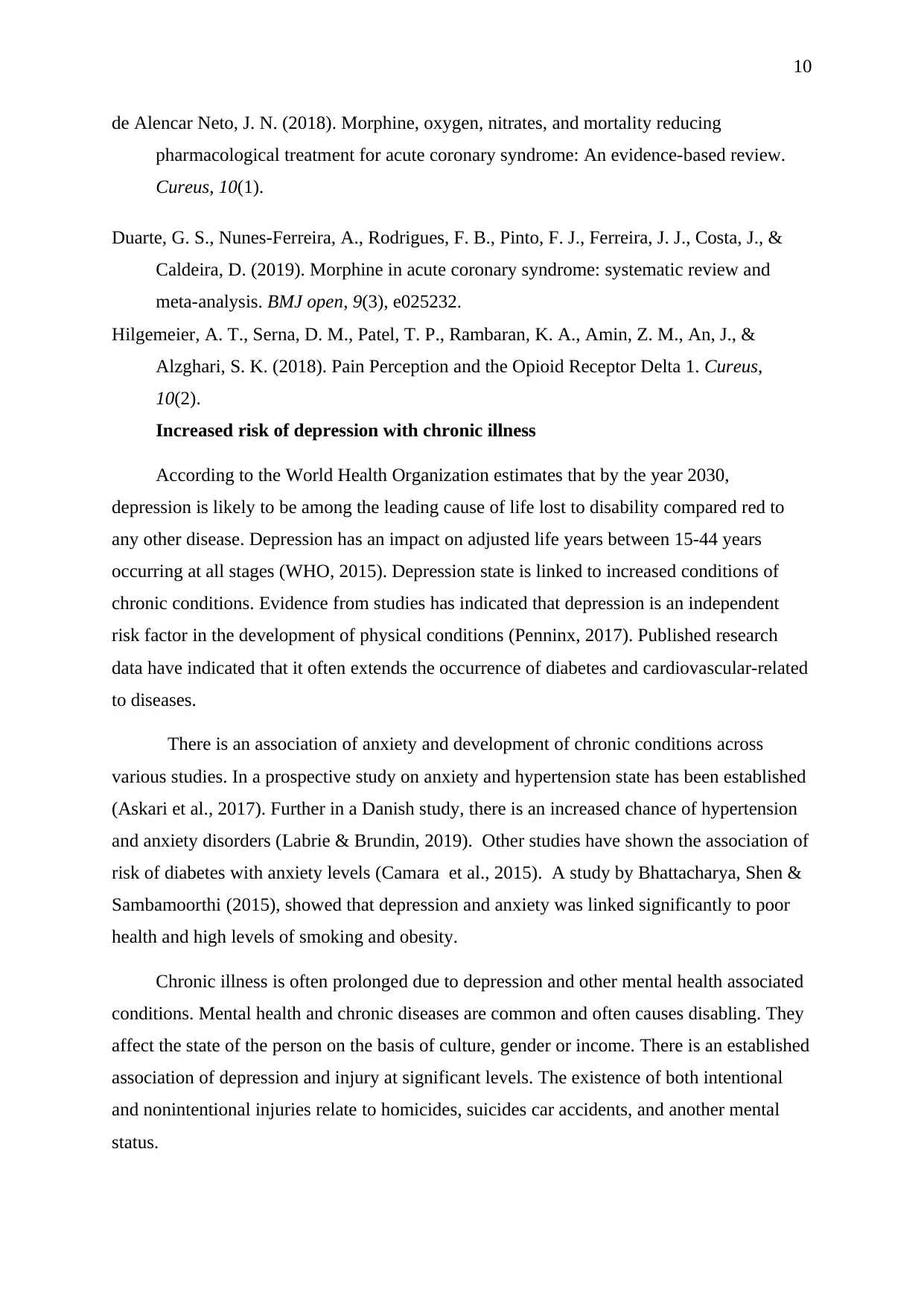
10
de Alencar Neto, J. N. (2018). Morphine, oxygen, nitrates, and mortality reducing
pharmacological treatment for acute coronary syndrome: An evidence-based review.
Cureus, 10(1).
Duarte, G. S., Nunes-Ferreira, A., Rodrigues, F. B., Pinto, F. J., Ferreira, J. J., Costa, J., &
Caldeira, D. (2019). Morphine in acute coronary syndrome: systematic review and
meta-analysis. BMJ open, 9(3), e025232.
Hilgemeier, A. T., Serna, D. M., Patel, T. P., Rambaran, K. A., Amin, Z. M., An, J., &
Alzghari, S. K. (2018). Pain Perception and the Opioid Receptor Delta 1. Cureus,
10(2).
Increased risk of depression with chronic illness
According to the World Health Organization estimates that by the year 2030,
depression is likely to be among the leading cause of life lost to disability compared red to
any other disease. Depression has an impact on adjusted life years between 15-44 years
occurring at all stages (WHO, 2015). Depression state is linked to increased conditions of
chronic conditions. Evidence from studies has indicated that depression is an independent
risk factor in the development of physical conditions (Penninx, 2017). Published research
data have indicated that it often extends the occurrence of diabetes and cardiovascular-related
to diseases.
There is an association of anxiety and development of chronic conditions across
various studies. In a prospective study on anxiety and hypertension state has been established
(Askari et al., 2017). Further in a Danish study, there is an increased chance of hypertension
and anxiety disorders (Labrie & Brundin, 2019). Other studies have shown the association of
risk of diabetes with anxiety levels (Camara et al., 2015). A study by Bhattacharya, Shen &
Sambamoorthi (2015), showed that depression and anxiety was linked significantly to poor
health and high levels of smoking and obesity.
Chronic illness is often prolonged due to depression and other mental health associated
conditions. Mental health and chronic diseases are common and often causes disabling. They
affect the state of the person on the basis of culture, gender or income. There is an established
association of depression and injury at significant levels. The existence of both intentional
and nonintentional injuries relate to homicides, suicides car accidents, and another mental
status.
de Alencar Neto, J. N. (2018). Morphine, oxygen, nitrates, and mortality reducing
pharmacological treatment for acute coronary syndrome: An evidence-based review.
Cureus, 10(1).
Duarte, G. S., Nunes-Ferreira, A., Rodrigues, F. B., Pinto, F. J., Ferreira, J. J., Costa, J., &
Caldeira, D. (2019). Morphine in acute coronary syndrome: systematic review and
meta-analysis. BMJ open, 9(3), e025232.
Hilgemeier, A. T., Serna, D. M., Patel, T. P., Rambaran, K. A., Amin, Z. M., An, J., &
Alzghari, S. K. (2018). Pain Perception and the Opioid Receptor Delta 1. Cureus,
10(2).
Increased risk of depression with chronic illness
According to the World Health Organization estimates that by the year 2030,
depression is likely to be among the leading cause of life lost to disability compared red to
any other disease. Depression has an impact on adjusted life years between 15-44 years
occurring at all stages (WHO, 2015). Depression state is linked to increased conditions of
chronic conditions. Evidence from studies has indicated that depression is an independent
risk factor in the development of physical conditions (Penninx, 2017). Published research
data have indicated that it often extends the occurrence of diabetes and cardiovascular-related
to diseases.
There is an association of anxiety and development of chronic conditions across
various studies. In a prospective study on anxiety and hypertension state has been established
(Askari et al., 2017). Further in a Danish study, there is an increased chance of hypertension
and anxiety disorders (Labrie & Brundin, 2019). Other studies have shown the association of
risk of diabetes with anxiety levels (Camara et al., 2015). A study by Bhattacharya, Shen &
Sambamoorthi (2015), showed that depression and anxiety was linked significantly to poor
health and high levels of smoking and obesity.
Chronic illness is often prolonged due to depression and other mental health associated
conditions. Mental health and chronic diseases are common and often causes disabling. They
affect the state of the person on the basis of culture, gender or income. There is an established
association of depression and injury at significant levels. The existence of both intentional
and nonintentional injuries relate to homicides, suicides car accidents, and another mental
status.
Paraphrase This Document
Need a fresh take? Get an instant paraphrase of this document with our AI Paraphraser
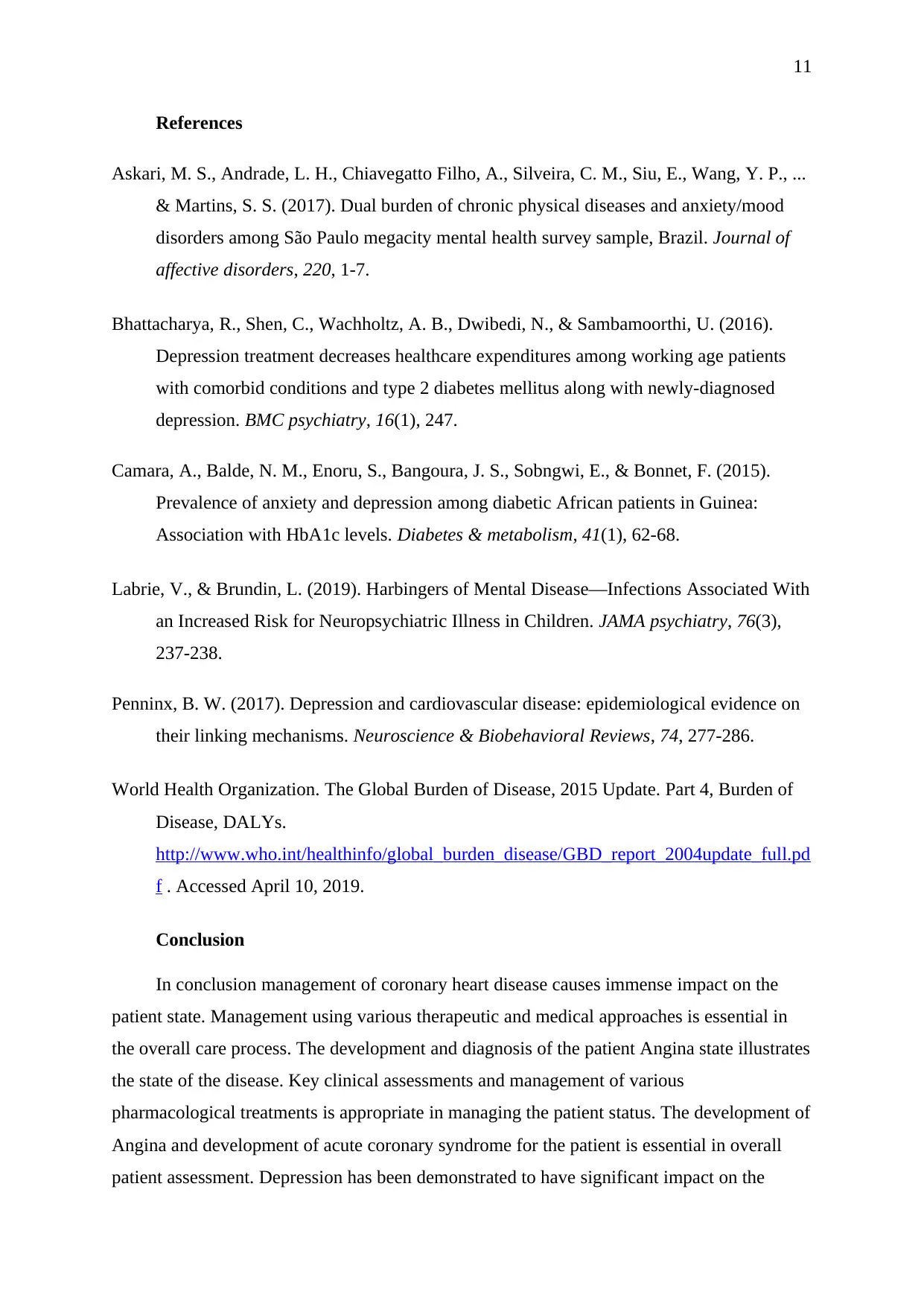
11
References
Askari, M. S., Andrade, L. H., Chiavegatto Filho, A., Silveira, C. M., Siu, E., Wang, Y. P., ...
& Martins, S. S. (2017). Dual burden of chronic physical diseases and anxiety/mood
disorders among São Paulo megacity mental health survey sample, Brazil. Journal of
affective disorders, 220, 1-7.
Bhattacharya, R., Shen, C., Wachholtz, A. B., Dwibedi, N., & Sambamoorthi, U. (2016).
Depression treatment decreases healthcare expenditures among working age patients
with comorbid conditions and type 2 diabetes mellitus along with newly-diagnosed
depression. BMC psychiatry, 16(1), 247.
Camara, A., Balde, N. M., Enoru, S., Bangoura, J. S., Sobngwi, E., & Bonnet, F. (2015).
Prevalence of anxiety and depression among diabetic African patients in Guinea:
Association with HbA1c levels. Diabetes & metabolism, 41(1), 62-68.
Labrie, V., & Brundin, L. (2019). Harbingers of Mental Disease—Infections Associated With
an Increased Risk for Neuropsychiatric Illness in Children. JAMA psychiatry, 76(3),
237-238.
Penninx, B. W. (2017). Depression and cardiovascular disease: epidemiological evidence on
their linking mechanisms. Neuroscience & Biobehavioral Reviews, 74, 277-286.
World Health Organization. The Global Burden of Disease, 2015 Update. Part 4, Burden of
Disease, DALYs.
http://www.who.int/healthinfo/global_burden_disease/GBD_report_2004update_full.pd
f . Accessed April 10, 2019.
Conclusion
In conclusion management of coronary heart disease causes immense impact on the
patient state. Management using various therapeutic and medical approaches is essential in
the overall care process. The development and diagnosis of the patient Angina state illustrates
the state of the disease. Key clinical assessments and management of various
pharmacological treatments is appropriate in managing the patient status. The development of
Angina and development of acute coronary syndrome for the patient is essential in overall
patient assessment. Depression has been demonstrated to have significant impact on the
References
Askari, M. S., Andrade, L. H., Chiavegatto Filho, A., Silveira, C. M., Siu, E., Wang, Y. P., ...
& Martins, S. S. (2017). Dual burden of chronic physical diseases and anxiety/mood
disorders among São Paulo megacity mental health survey sample, Brazil. Journal of
affective disorders, 220, 1-7.
Bhattacharya, R., Shen, C., Wachholtz, A. B., Dwibedi, N., & Sambamoorthi, U. (2016).
Depression treatment decreases healthcare expenditures among working age patients
with comorbid conditions and type 2 diabetes mellitus along with newly-diagnosed
depression. BMC psychiatry, 16(1), 247.
Camara, A., Balde, N. M., Enoru, S., Bangoura, J. S., Sobngwi, E., & Bonnet, F. (2015).
Prevalence of anxiety and depression among diabetic African patients in Guinea:
Association with HbA1c levels. Diabetes & metabolism, 41(1), 62-68.
Labrie, V., & Brundin, L. (2019). Harbingers of Mental Disease—Infections Associated With
an Increased Risk for Neuropsychiatric Illness in Children. JAMA psychiatry, 76(3),
237-238.
Penninx, B. W. (2017). Depression and cardiovascular disease: epidemiological evidence on
their linking mechanisms. Neuroscience & Biobehavioral Reviews, 74, 277-286.
World Health Organization. The Global Burden of Disease, 2015 Update. Part 4, Burden of
Disease, DALYs.
http://www.who.int/healthinfo/global_burden_disease/GBD_report_2004update_full.pd
f . Accessed April 10, 2019.
Conclusion
In conclusion management of coronary heart disease causes immense impact on the
patient state. Management using various therapeutic and medical approaches is essential in
the overall care process. The development and diagnosis of the patient Angina state illustrates
the state of the disease. Key clinical assessments and management of various
pharmacological treatments is appropriate in managing the patient status. The development of
Angina and development of acute coronary syndrome for the patient is essential in overall
patient assessment. Depression has been demonstrated to have significant impact on the

12
overall diseases state of the patient. There is need for medical assessment for patient care
process.
overall diseases state of the patient. There is need for medical assessment for patient care
process.
⊘ This is a preview!⊘
Do you want full access?
Subscribe today to unlock all pages.

Trusted by 1+ million students worldwide
1 out of 14
Related Documents
Your All-in-One AI-Powered Toolkit for Academic Success.
+13062052269
info@desklib.com
Available 24*7 on WhatsApp / Email
![[object Object]](/_next/static/media/star-bottom.7253800d.svg)
Unlock your academic potential
Copyright © 2020–2025 A2Z Services. All Rights Reserved. Developed and managed by ZUCOL.





